>> Back to The HooK front page
COVER- Brown's birthday: The road to equality in Charlottesville
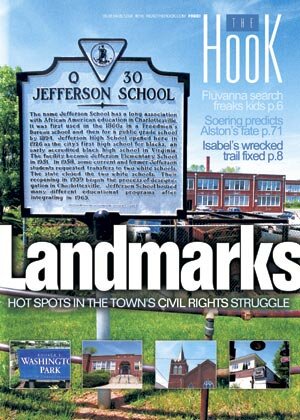
Published May 6, 2004, in issue 0318 of The Hook
BY LISA PROVENCE
PHOTOS BY JEN FARIELLO
Being able to use a bathroom is a basic human right-- or at least, a basic decency one human extends to another, right?
Not under segregation, the degradations of which touched every aspect of life, even the right to use a public restroom or water fountain. And sometimes, "colored" bathrooms weren't even provided, as African Americans traveling through the Jim Crow South knew all too well.
That's how far reaching the Brown v. Board of Education Supreme Court decision was. Sure, its thrust was education, its purpose to dismantle the misnamed "separate but equal" laws that had relegated blacks to substandard schools since Reconstruction.
But once public schools were open to African Americans, the walls of segregation began to crack. It didn't all happen on May 17, 1954, the date of the Brown decision, and many will argue that the job still isn't done.
To look back 50 years, to when there were "colored" balconies in Charlottesville theaters, and black citizens could not get served in restaurants, when it was legal to discriminate in housing, jobs, transportation, and public access, well, it seems like ancient history. But not for the people who lived it, who remember half a century ago when such treatment of fellow citizens was the norm.
On the anniversary of the landmark civil rights decision of the 20th century, it's important that we, too, remember that part of our history, with a look at some local landmarks in the civil rights struggle.
Happy birthday, Brown.

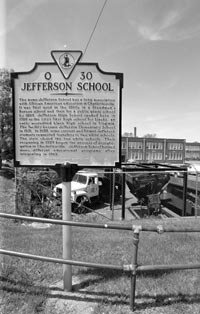
Jefferson School
201 Fourth Street NW
Today Jefferson School is still the most controversial symbol of the city's uneasy racial past. An addition in 1958, four years after Brown, is a testament to the city fathers' determination to keep schools segregated. Before the current structure opened in 1926, Charlottesville blacks who wanted a high school education had to go elsewhere. In the 1930s, Jefferson was one of a half dozen accredited high schools for blacks in Virginia, even though its teachers were paid half what their white counterparts earned and were always short of supplies.
The now-empty building ended its career as a school in 2002. It survived the razing of Vinegar Hill in the 1960s, but nearly fell to developers when the city was ready to sell the dilapidated, lead- and asbestos-ridden building on a primo piece of real estate. "Within it is embodied much of the cultural legacy of African Americans in this community," says Mayor Maurice Cox. He foresees an African-American cultural center and a library in its once precarious future.

Jackson P. Burley High School
901 Rose Hill Drive
Before Burley opened in 1951 for city and county black students, there were three black high schools: Esmont, Jefferson, and the Albemarle Training School. In 1949, the county school board decided to "unite the Negroes' high schools" to provide better facilities and programs, according the June 1967 Burley Bulletin. With the city, for $18,000, Albemarle purchased 17 acres of land from Mrs. Jackson P. Burley, wife of the teacher and storeowner for whom the school is named. Marcha Howard, now assistant principal at Burley, endured an hour-long bus ride from her home near Proffit Road to attend Burley when she started as a freshman in 1959. "It was a long ride for a lot of students," she says.
The city/county venture was an irritation to city residents like Julia Martin, whose sons had to walk past the all-white Lane High School to reach Burley. And when county schools were closed for bad weather, so, too, was Burley-- even though city students had no problem getting there. Martin joined a lawsuit against the Charlottesville School Board to send her sons to Lane. Burley remained segregated until 1967, when it became a junior high. Today Burley is a county middle school in the middle of the city, and in an echo of the past, students who live right across the street can't go there.

Lane High School
401 McIntire Road
Now the Albemarle County Office Building, Lane High School, which opened to students in 1940, was Charlottesville's white high school when the Brown v. Board decision was handed down in 1954. And when 12 black students prevailed in their lawsuit to attend Lane and Venable Elementary, Governor Lindsay Almond ordered the two schools shut in September 1958. They remained closed until February 4, 1959. The 1959 Lane yearbook, The Chain, is all about the students' coping with massive resistance that closed their school for most of the year and shipped them into makeshift classrooms. The 1960 Chain makes no mention of that school year's even more momentous event: John Martin, Donald Martin, and French Jackson became the first African Americans to attend Lane High School.

Paramount Theater
215 East Main Street
When it opened its doors in 1931, the Paramount allowed African Americans to come in-- through the "colored entrance" on Third Street. That wasn't unusual. The Jefferson Theater, too, steered African Americans upstairs to the "colored" mezzanine and restrooms, and the University Theater on the Corner (now apartments) didn't allow blacks at all because it didn't have a balcony. The Paramount wasn't integrated until 1964. Currently undergoing a multi-million dollar renovation, the Paramount plans to retain the "colored entrance" as a symbol of its segregated past, and is working on how to best memorialize the African-American experience there.
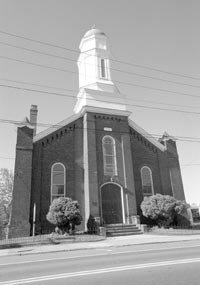
First Baptist Church
632 West Main Street
During segregation, black churches served as community centers, and Charlottesville's were no exception. After Abraham Lincoln issued the Emancipation Proclamation in 1863, 800 blacks who'd worshiped in the segregated balcony of First Baptist Church on Jefferson Street decided to start their own congregation. They met at the Delevan Hotel-- the church was known as Delevan Baptist. That building was razed in 1876, and the current structure opened for worship in 1883. In 1983, it was designated a historic landmark. Church members have been active in civil rights since 1931: The Reverend Benjamin Bunin was a founder of the local chapter of the NAACP.
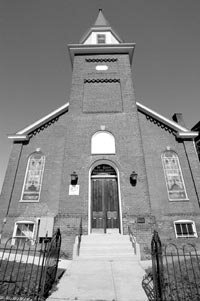
Mt. Zion Baptist Church
105 Ridge Street
Founded in 1867, Mt. Zion is Charlottesville's second oldest African-American church and is on the National Register of Historic Places and the Virginia Landmarks register. The Italianate and classical revival building was built in 1884, and served the Mt. Zion congregation until it relocated last year. The church has served as a community center throughout its history, most recently when black Charlottesville High students attacked white UVA students in 2001, and congregants rallied to the black youths' defense. The structure, now owned by Gabe Silverman, continues to serve the community as the Music Resource Center.

Washington Park
Preston Avenue
The site was known as the Pest House Property, stemming from a scarlet fever epidemic in 1905. By 1916, the land had become an unofficial dump, according to the city parks website. Community philanthropist Paul Goodloe McIntire (of McIntire Park fame) bought the property in 1926, and donated the land as "a public park and playground for the colored people of Charlottesville." Says Eugene Williams, "Parks were not popular for black people in the early years. They were too much of a luxury." A "Colored Recreation Board" was formed in 1934. And although one of its first requests to the city was for water, the park didn't get a water fountain until 1942. Black civic organizations helped clear and landscape the site, which included three tennis courts, a baseball diamond, and a rec building called "the Barn." A wading pool was built in 1950, although the park still lacked "adequate dressing rooms and toilet facilities," according to the city's history of the park.
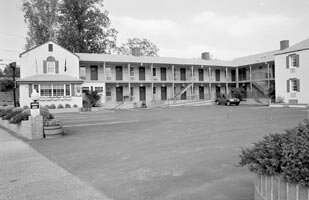
The Budget Inn/Gallery Court
140 Emmet Street
When Martin Luther King came to Charlottesville on March 25, 1963, the Budget Inn was known as the Gallery Court and was one of the few places in town where blacks could stay. After King's speech at Cabell Hall, UVA history prof and civil right activist Paul Gaston went back to King's room with him, and remembers King saying, "I'll be shot at sometime." He was, April 4, 1968, at another motel in Memphis.
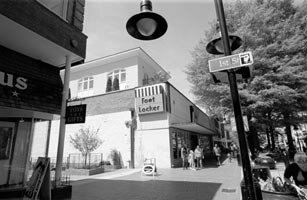
Woolworth's
100 Main Street
Today it's a national shoe store chain on the Downtown Mall, with the swanky Terraces retail and residential in back and on top. Fifty years ago, it was a five and dime. Blacks could shop in Woolworth's-- but they couldn't sit down and eat at the counter. Then a February 1, 1960, sit-in by four black college students at the Woolworth's in Greensboro, NC, made national headlines, and became a tactic for desegregation actions around the south. Scheryl Williams Glanton remembers sitting in at Woolworth's with her father, Eugene Williams. She was a little girl who wanted a milkshake-- but she couldn't be served because of the color of her skin.

Buddy's
104 Emmet Street
The site of Charlottesville's first violent racial encounter during the civil rights movement, Buddy's offered breakfast, lunch, dinner, and fountain service-- unless you were black. Owner Buddy Glover actually had served some African Americans, such as visiting musicians and athletes, according to Coy Barefoot's local history, The Corner. But when a group of whites and blacks sat down to eat at Buddy's Memorial Day weekend in 1963, they were ignored until closing, and when they came back the next day, they weren't allowed in the restaurant. UVA history professor Paul Gaston and two black leaders, Floyd Johnson and William Johnson, were beaten up, and after the maelstrom of bad publicity following that incident, restaurants, movies and theaters all over town suddenly desegregated. But not Buddy's, which remained segregated until July 2, 1964, the day the Civil Rights Act passed. That day Buddy's closed. Today it's the Virginia Museum of Natural History.

Thomas Jefferson Memorial Church
717 Rugby Road
Unitarians have always been known for their liberal bent, so it's not surprising that the church hosted meetings of the Council on Human Relations, one of Charlottesville's only integrated groups in the 1950s. After federal Judge John Paul ruled in favor of the Allen v. Charlottesville School Board plaintiffs and ordered Charlottesville to integrate Lane High School and Venable Elementary, tensions soared. The Seaboard White Citizen's Council came down from New Jersey to show its displeasure with desegregation by burning a cross in front of the church on August 23, 1956.
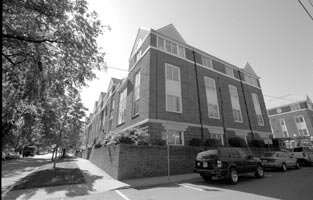
Dr. Frank Daniel's house
202 E. High Street
Now the site of Queen Charlotte Square, in 1955, it was the site of another cross burning. Dr. Frank Daniel, a beloved family doctor, was active in the local NAACP and the Council on Human Relations. His daughter, Nancy, a sixth-grader at the time, was terrified when she saw the charred cross in her front yard and realized that someone was out to get her father. She says the Progress reported a six-foot cross, but that it was no bigger than four feet. The pieces of wood were hauled down to the basement, and the family never spoke of the incident-- at least not around Nancy.

The Holiday Inn restaurant
1600 Emmet Street
In the 1960s, long before it became a Red Lobster and a Days Inn, the Holiday Inn would rent rooms to blacks-- but wouldn't allow them to eat in the separately owned restaurant. That practice led to a sit-in the summer of 1963. Eugene Williams and area ministers went to the restaurant and were ignored by the waitresses while one white couple was served. After the couple ate, Williams says, they patted the Rev. R.J. Kennedy of Zion Union Baptist Church on the shoulder and congratulated the group.
"We spent a whole, solid day there," recalls Williams, who loaded his station wagon with kids and took them to the restaurant, where they spread out at tables. The restaurant closed after lunch, and the group left. But Williams knew the dining room would reopen at 5pm to serve dinner, and the protesters were waiting there when it did. "The manager came out and said, 'Can we sit down and talk about this?'" says Williams. "He said, 'If I give you my word we will integrate Sunday morning, will you not picket tonight?' We agreed." The Holiday Inn restaurant was integrated the next morning.

Bell Funeral Home
108 Sixth Street
Raymond Bell, who died in April, was one of the founders of Charlottesville's very active NAACP. One reason funeral home owners often became civil rights leaders across the South was that they served the black community, so they didn't face the financial repercussions of business owners with a white customer base. Bell Funeral Home, the oldest African-American owned business in town, opened in 1917, when "there wasn't a white bank that would make a loan [to blacks]," Eugene Williams points out. "Ray Bell went to Boston University. Why didn't he go to the University of Virginia? Because they wouldn't admit him." And as much as the Charlottesville NAACP founders accomplished, Williams often talked with Bell about "how much more we could do if we had a better economic base."

George Ferguson's house
702 Ridge Street
George Ferguson, the son of a physician, was one of three black undertakers in Charlottesville when he started his business in 1941. "After looking at other things black people could do 50 years ago, the only professional opportunities available were to be a doctor, dentist, minister, or school teacher," he says in From Porch Swings To Patios: An Oral History Project of Charlottesville Neighborhoods, 1914-1980. "At that time, black lawyers weren't too popular." Ferguson's daughter, Olivia, was a plaintiff in Allen v. Charlottesville School Board. A federal judge assigned her to Lane in 1958-- the year Lane and Venable closed. When the schools reopened in February 1959, she spent the rest of her senior year sitting in the superintendent's office. Today the Ferguson house is the home of Charlottesville's third black mayor, Maurice Cox.

Ebenezer Baptist Church
113 Sixth Street NW
An offshoot of Mt. Zion, this historic church, across the street from Bell Funeral Home, just celebrated its 112th birthday in March.
>> Back to The HooK front page
|